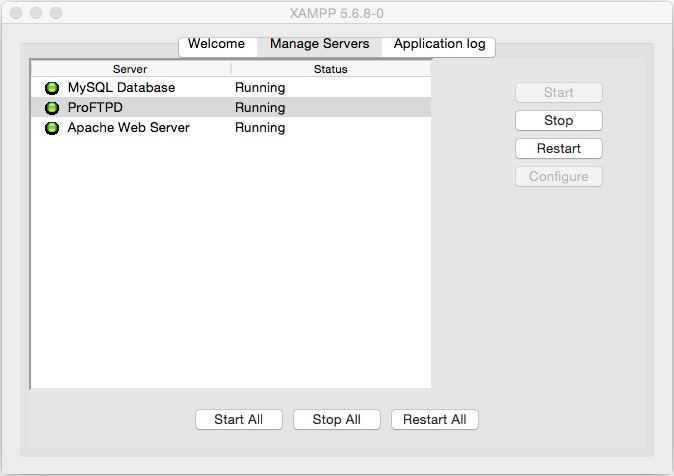Written in Various Languages | Development status Active | |
 | ||
Initial release May 22, 2002; 14 years ago (2002-05-22) Stable release 7.1.1 - Windows7.1.1 - Linux7.1.1 - macOS / February 1, 2017; 2 months ago (2017-02-01) Repository | ||
XAMPP (/ˈzæmp/ or /ˈɛks.æmp/) is a free and open source cross-platform web server solution stack package developed by Apache Friends, consisting mainly of the Apache HTTP Server, MariaDB database, and interpreters for scripts written in the PHP and Perl programming languages. XAMPP stands for Cross-Platform (X), Apache (A), MariaDB (M), PHP (P) and Perl (P). It is a simple, lightweight Apache distribution that makes it extremely easy for developers to create a local web server for testing and deployment purposes. Everything needed to set up a web server – server application (Apache), database (MariaDB), and scripting language (PHP) – is included in an extractable file. XAMPP is also cross-platform, which means it works equally well on Linux, Mac and Windows. Since most actual web server deployments use the same components as XAMPP, it makes transitioning from a local test server to a live server extremely easy as well.
Contents
Etymology
The term XAMPP is an apparent acronym. However, there is no official acronym expansion specified on the Apache Friends website. Their homepage header reads “XAMPP Apache + MariaDB + PHP + Perl”, indicating that this abbreviation is a recursive acronym.
The term can be unofficially broken down as follows:
MySQL was replaced with MariaDB on 2015-10-19 and beginning with XAMPP versions 5.5.30 and 5.6.14, effectively altering the meaning of the acronym.
While both letters P are de facto interchangeable, convention used at the Apache Friends website indicates that the first letter P is short for PHP and the latter letter P is short for Perl.
Prerequisites
XAMPP requires only one zip, tar, 7z, or exe file to be downloaded and run, and little or no configuration of the various components that make up the web server is required.
Features
XAMPP is regularly updated to the latest releases of Apache, MariaDB, PHP and Perl. It also comes with a number of other modules including OpenSSL, phpMyAdmin, MediaWiki, Joomla, WordPress and more. Self-contained, multiple instances of XAMPP can exist on a single computer, and any given instance can be copied from one computer to another. XAMPP is offered in both a full and a standard version (Smaller version).
Usage
Officially, XAMPP's designers intended it for use only as a development tool, to allow website designers and programmers to test their work on their own computers without any access to the Internet. To make this as easy as possible, many important security features are disabled by default. XAMPP has the ability to serve web pages on the World Wide Web. A special tool is provided to password-protect the most important parts of the package.
XAMPP also provides support for creating and manipulating databases in MariaDB and SQLite among others.
Once XAMPP is installed, it is possible to treat a localhost like a remote host by connecting using an FTP client. Using a program like FileZilla has many advantages when installing a content management system (CMS) like Joomla or WordPress. It is also possible to connect to localhost via FTP with an HTML editor.
Components
XAMPP 7.1.1 for Windows and Linux, Mac OSX, including:
